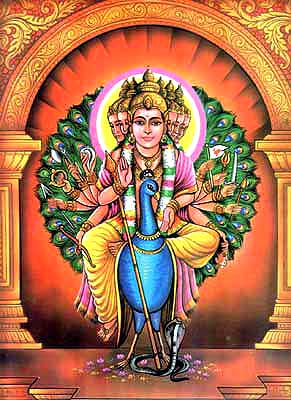
How The Warrior God Helps The Faithful
by Aryadasa Ratnasinghe
(Colombo: The Sunday Observer of June 28, 1992)
God Kataragama is popularly known among the Hindus as God Skanda and the Saivites of South India call the god Subrahmanya. The other names applicable to the deity, as mentioned in the Hindu texts are: Kandasamy, Kadiradeva, Kadiravel, Tarakajit etc., and in the Hindu Puranas (ancient holy scriptures), the names associated with him are: Guha, Saktidhara, Gangaputra, Sarabhu, Yudaranga, Irjukaya etc.
Sinhala literary works refer to the god as Dev-Senevi (Commander of the Divine Army, Kande Kumara (Prince of the Mountain), Sikhiyahan (peacock vehicled), Adayatidhara (Spear bearer), Mahasena ('Who has a Great Army'), Siddhasenapati (Indefatigable Commander), Baraneth (Multi-eyed), Huthasyon (Fiery Fighter) etc., but generally known as Kataragama Deviyo (the tutelary deity of Kataragama).
Kataragama is a village situated 290 km (179 miles) from Colombo, and the nearest town is Tissamaharama 20 km (12 miles) away. It is one of the sixteen principal places of Buddhist pilgrimage. According to the Great Chronicle (Mahavamsa) of the island, kshatriyas (warriors) from Kataragama were present when the Bo-sapling was brought to Anuradhapura from India 2,300 years ago by the Theri Sanghamitta (Mhv. Ch. 19:53).
The anthropomorphic image of God Kataragama has six heads and twelve hands and hence known as Shanmukha ('six-headed') and Dvadasakara ('twelve-handed'). The god's vahana (vehicle) is the bird peacock called Paravani. The peacock is a gallinaceous bird (akin to the domestic fowl), native to Sri Lanka and India, having a fan-like tail brightly coloured with blue, green and purple 'eyes' on a lovely chestnut background. It bears the scientific name Pavo cristatus, and is a sacred bird mostly found in the wild sanctuary of Yala.
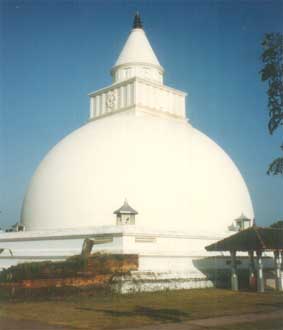 In keeping with the Pali epithet 'Mahasena devassa sammananiyam' (Praise be to god Mahasena), the Sinhalese call the God Kataragama as Mahasen Devi and believe him to be a warrior god. The saying 'Vikumen sadisi Mahasen' (the valorous Mahasena) confirms the belief. In keeping with the Pali epithet 'Mahasena devassa sammananiyam' (Praise be to god Mahasena), the Sinhalese call the God Kataragama as Mahasen Devi and believe him to be a warrior god. The saying 'Vikumen sadisi Mahasen' (the valorous Mahasena) confirms the belief.
The Kirivehera chetiya , which stands close to the Kataragama Mahadevale, was built by King Mahasena who ruled over Mahagama (now Tissa) in Rohana. History says that when the Buddha made his last visit to the island, in the eighth year of His enlightenment (BC 580), he met the king at the spot where the chetiya now stands. Having listened to the Buddha's discourse, the king attained the higher faculty of sovan (the first stage of spiritual eminence as taught in Buddhism), and as a token of gratitude, the chetiya was built on that exact spot. After his death, the king is believed to have been elevated to the position of a deity wielding his mighty authority over Kataragama.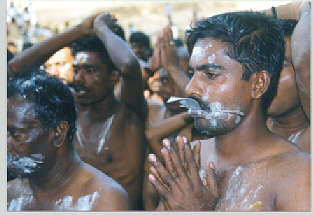
The Sinhalese fulfil vows made to the god without voluntary mortification of the flesh, unlike the Hindus who undergo various forms of subdued severities in fulfilling their vows by fire-walking, hanging by the flesh, walking upon nailed slippers, drawing carts by ropes clinched to the muscles of the back, piercing the cheeks or tongue with metal pins, rolling on the ground wearing just a loin-cloth and in such other ways befitting ordeal.
The Menik Ganga at Kataragama is a sacred river which begins from the Namunukula mountain range in Uva and flows close to the Mahadevale, discharging its confluence into the sea east of Hambantota, covering a distance of 114 km (71 miles). It is customary, if not compulsory, for devotees to perform their ablutions by bathing and washing in the river before entering the Devale to offer poojas, make vows, pay homage, beseech help, etc.
The river abounds in fish, but none dare catch them through fear of divine wrath. I once heard a story that a man, regardless of consequences, had caught some fish from the river to fill his dishes on the table. After eating the curry, he had developed a severe colic and had purged badly, without any response to medicine. Finally, he had to beseech divine help of the god to cure himself from the disorder by pleading pardon for eating the fish. He was cured only thereafter. 
The road from Tissa to Kataragama runs through the wilderness of the wildlife sanctuary abounding with fauna and flora. About two kilometers before reaching the Mahadevale, there can be seen a picturesque range of mountains to the right. One of them is the holy Vedisitikanda, the abode of the God Kataragama. It is also known as Hemakutaya, Dakshina Kailasaya, Anjana Parvata, Sinhasanakanda and Medumhelaya. The other surrounding sister mountains are known as Kadawara-kanda, Prakasha-kande, Umang-Kanda and Bandara-Kanda, which rise from the lower valley overlooking the verdant ground below.
There is a belief that the original devale, dedicated to the god, stood atop the Vedisiti-kanda, before the present devale was built. The weapon of the god, known as Velayudha (spear-weapon), is believed to lie buried in the old devale. Pictures of the god depict him carrying the weapon in one of his hands.
God Kataragama is popular as the God of War and acclaimed as the warrior god Tarakajit because he had successfully slain the powerful asura (demon) Taraka at the Battle of Velupuram in South India and subsequently killed his two brothers, the demons Surapadma and Sinhamukha, who were a nuisance to the gods, in order to save them from harassment. The annual Vel festival of the Hindus is reminiscent of the god's valour and heroism in killing the demons with his weapon Velayudha. Hence the name Kadiravel. 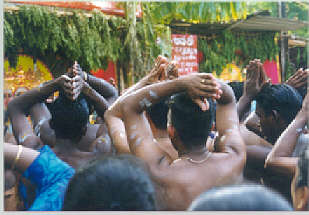
The great Sanskrit epics Mahabharata (BC 300) and Ramayana (BC 500), written during the heroic age of India, have reference to the god Skanda and his exploits at war. Hindus show their devotion to the god by clamouring 'Haro Hara!' as they approach the Mahadevale in profound faith.
Legend has it that King Dutugemunu (BC 161-137), before embarking on his war campaign against the Tamil King Elara (BC 205-161), had gone to the Vedisiti-kanda in the company of his loyal minister Bharana to pay homage to the god. The king had vowed that he would build a devale in honour of the god on his successful return from the war front. Later, having killed the King Elara at the Battle of Vijiapura, had returned triumphantly to Kataragama and fulfilled the vow by building a new devale. It is what we see today. Since then, the kapuralas (officiating priests) of the Mahadevale have been Sinhalese down the generations.
Truly speaking, the God Kataragama came into prominence during the Kandyan period (1480-1815) with the ascendancy of Nayakkar kings from South India, who ruled the island for 76 years (1739-1815). According to the text Ganadevihelle (1754), the four guardian gods of the country were Vishnu, Saman, Boksal and Vibhisana, but now the four are mentioned as Natha, Vishnu, Kataragama and Pattini and the four devales dedicated to them participate in the Kandy Esala Perahera.
Among the sandesa kavyas (message poems), the new Mayura Sandesaya (1859) and the Nilacobo Sandesaya (1790) were written invoking the blessings of God Kataragama to cure certain ailments which had not responded to medicine.
As Hindus assert, the deities Skanda and Pattini are of Indian origin, and the Nayakkar kings appear to have promoted the worship of the two in addition to other gods that were in vogue at the time. The early history of the island does not make reference to God Kataragama, nor had the kings showed their benefactions to the Mahadevale at Kataragama. 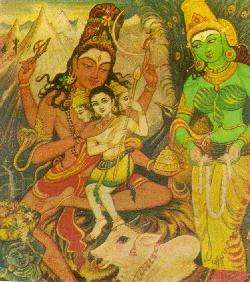
The speculative ferment in regard to the birth of god Skanda is vivid and varied as described in the Hindu puranas. One story is that, once tongues of fire began to spread from the eye on the forehead of god Iswara/Shiva and they fell into the Saravana pond. From them arose six sweet-looking infants and they were sustained by the wives of six rishis (sages). The goddess Parvati, consort of god Iswara, having seen the six lovely children, had caught hold of them together and they merged to form a single child with six faces and twelve hands.
Another story is that the demon Bhasma laboured for the god Iswara for twelve years with the intention of procuring a certain powerful charm, only known to the god, which could reduce anything to ash. In the final year, the demon begged for the charm in lieu of services rendered to the god and managed to get the charm enchanted into his right palm.
One day the demon, wishing to test the efficacy of the charm, tried to place the palm on the god's head and he, realizing the danger, began to flee pursued by the demon. God Visnu, in order to save Iswara, appeared as a beautiful woman and stood on the way to attract the demon. The demon seeing her stopped running, approached her and began to talk to her. The woman's lascivious looks made him to abandon the chase and wished to possess her.
The demon asked her whether she was married or not. The woman replied that she could give him an answer only if he would swear by keeping his palms on his head that he would never desert her. The demon to satisfy his lustful longings, and forgetting the charm on his palm, kept both on his head in averment. At once, he was reduced to ashes.
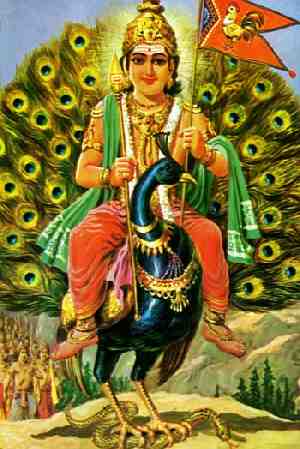 God Iswara turned back to see the demon and as he was missing, thought that he would have given up the chase. Suddenly, he saw a woman standing beside him. He fell in love with her and expressed his desire to marry her. The woman, knowing that the god Iswara has a consort, requested him to go and get her consent to the marriage. When the god returned, he found that the woman had given birth to a son, and she told him to go again and get the consent of marry a carrying mother as she has conceived again. God Iswara turned back to see the demon and as he was missing, thought that he would have given up the chase. Suddenly, he saw a woman standing beside him. He fell in love with her and expressed his desire to marry her. The woman, knowing that the god Iswara has a consort, requested him to go and get her consent to the marriage. When the god returned, he found that the woman had given birth to a son, and she told him to go again and get the consent of marry a carrying mother as she has conceived again.
Similarly, for six times, the god had to go and obtain the required consent from his consort. Finally, suspecting it to be a trick of god Visnu, the consort, along with Iswara, went to see the woman. As she saw her with six children, she embraced them together. At once, they were transformed into one child with six faces and twelve hands. As the child grew up, and knowing his valour, god Iswara made him Devasenapati (Commander of the Divine Army). The Skanda, Siva and Agni Puranas deal with stories pertaining to the nativity of Skanda and his heroism at war.
It is believed by the Hindus that god Skanda is the younger son of god Iswara Siva who, as Mahadeva, is the Creator symbolized by the lingam (phallus) and who, as Mahakala, is the destroyer of what he restores. God Ganesha is the elder brother of god Skanda and it may be for this reason that the two devales, dedicated to the brothers, lie adjacent to each other at Kataragama. Unlike at the Mahadevale, the kapuralas of the Ganesha kovil are Hindus. 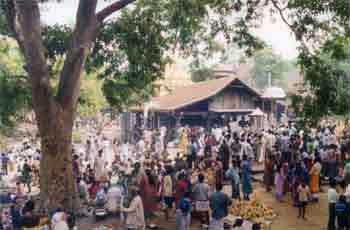
Devotees who go to Kataragama Mahadevale make it a point to visit Sella Kataragama too, which is about three miles away, situated on the left bank of the Menik Ganga, known in ancient times as Kapparakanda Nadi. Legend says that the two brothers, Skanda and Ganesha, spent their childhood days at Sella Kataragama, and it was there that God Kataragama met the local damsel Valli and kept her as his consort, in addition to Thevani. Two devales dedicated to the consorts are found at this historic place.
According to Hindu mythology, god Skanda has no mother, but was born of shakti (the female principle) of god Iswara whose gene was thrown into fire, and having been picked up by the waters of the Ganges, began to float down the river when the god sprang therefrom. Hence, the god is called Agnibhu (born from Fire) and Gangeya (born from the Ganges). 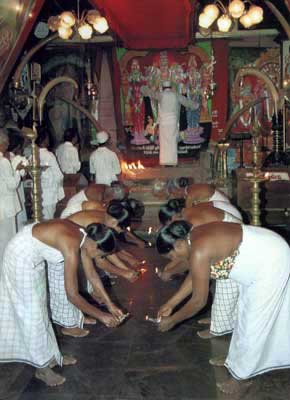
Those who have been to the Kataragama Mahadevale would have seen that, before the commencement of each puja (offering to the god), two women come on the scene and perform certain traditional rituals conforming to custom. These two are said to represent the two consorts of the god.
Puja is a sacred offering and includes only nuts and fruits, with the indispensable coconut in the tray. It is a 'must'. The fruit trays made available for sale in the market are of poor quality, and some nuts and fruits are either old or rotten or not ripe, and have only the commercial value. The best is to have a tray prepared under personal supervision using the best items.
Buddhists and Hindus alike show great reverence to God Kataragama, irrespective of their beliefs, and honour him as a very powerful deity for beseeching divine help to overcome mundane obstacles, or for success in undertakings, business enterprises, etc., with the fervent hope that their requests would be granted. For purposes of convenience, most Buddhist temples have separate shrine rooms dedicated to God Kataragama because today divine worship has become part and parcel of Buddhist worship.
Buddhism does not totally repudiate polytheism, for gods remain, but to Buddhists they rank subordinate in importance, unlike Hinduism which advocates salvation or liberation through approach of the divine. This stage of mental abstraction solely depends on sheer belief and such concept of motivation is attributed principally to the subconscious feeling that gods exist and help mankind in times of distress or calamity when invoked with faith and devotion.

|